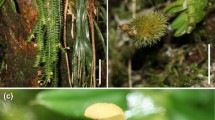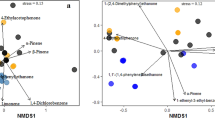Abstract
Mutualists and antagonists may place conflicting selection pressures on plant traits. For example, the evolution of floral traits is typically studied in the context of attracting pollinators, but traits may incur fitness costs if they are also attractive to antagonists. Striped cucumber beetles (Acalymma vittatum) feed on cucurbits and are attracted to several volatiles emitted by Cucurbita blossoms. However, the effect of these volatiles on pollinator attraction is unknown. Our goal was to determine whether pollinators were attracted to the same or different floral volatiles as herbivorous cucumber beetles. We tested three volatiles previously found to attract cucumber beetles in a factorial design to determine attraction of squash bees (Peponapis pruinosa), the specialist pollinators of cucurbita species, as well as the specialist herbivore A. vittatum. We found that 1,2,4-trimethoxybenzene was attractive to both the pollinator and the herbivore, indole was attractive only to the herbivore, and (E)-cinnamaldehyde was attractive only to the pollinator. There were no interactions among volatiles on attraction of squash bees or cucumber beetles. Our results suggest that reduced indole emission could benefit plants by reducing herbivore attraction without loss of pollination, and that 1,2,4-trimethoxybenzene might be under conflicting selection pressure from mutualists and antagonists. By examining the attraction of both mutualists and antagonists to Cucurbita floral volatiles, we have demonstrated the potential for some compounds to influence only one type of interaction, while others may affect both interactions and possibly result in tradeoffs. These results shed light on the potential evolution of fragrance in native Cucurbita, and may have consequences for yield in agricultural settings.


Similar content being viewed by others
References
Adler, L. S. 2007. Selection by pollinators and herbivores on attraction and defense, in K. J. Tilmon (ed.). Specialization, Speciation and Radiation: The Evolutionary Biology of Herbivorous Insects. University of California Press, Berkley (in press).
Adler, L. S., and Bronstein, J. L. 2004. Attracting antagonists: Does floral nectar increase leaf herbivory? Ecology 85:1519–1526.
Adler, L. S., Wink, M., Distl, M., and Lentz, A. J. 2006. Leaf herbivory and nutrients increase nectar alkaloids. Ecol. Lett. 9:960–967.
Allen-Wardell, G., Bernhardt, P., Bitner, R., Burquez, A., Buchmann, S., Cane, J., Cox, P. A., Dalton, V., Feinsinger, P., Ingram, M., Inouye, D., Jones, C. E., Kennedy, K., Kevan, P., Koopowitz, H., Medellin, R., Medellin-morales, S., Nabhan, G. P., Pavlik, B., Tepedino, V., Torchio, P., and Walker, S. 1998. The potential consequences of pollinator declines on the conservation of biodiversity and stability of food crop yields. Conserv. Biol. 12:8–17.
Andersen, J. F. and Metcalf, R. L. 1986. Identification of a volatile attractant for Diabrotica (Coleoptera, Chrysomelidae) and Acalymma (Coleoptera, Chrysomelidae) spp from blossoms of Cucurbita maxima Duchesne. J. Chem. Ecol. 12:687–699.
Andersen, J. F. and Metcalf, R. L. 1987. Factors influencing distribution of Diabrotica spp (Coleoptera, Chyrsomelidae) in blossoms of cultivated Cucurbita spp. J. Chem. Ecol. 13:681–699.
Ashman, T. L., Bradburn, M., Cole, D. H., Blaney, B. H., and Raguso, R. A. 2005. The scent of a male: The role of floral volatiles in pollination of a gender dimorphic plant. Ecology 86:2099–2105.
Ashman T.L., Cole, D. H., and Bradburn, M. 2004a. Sex-differential resistance and tolerance to herbivory in a gynodioecious wild strawberry. Ecology 85:2550–2559.
Ashman T. L., Knight, T. M., Steets, J. A., Amarasekare, P., Burd, M., Campbell, D. R., Dudash, M. R., Johnston, M. O., Mazer, S. J., Mitchell, R. J., Morgan, M. T., and Wilson, W. G. 2004b. Pollen limitation of plant reproduction: Ecological and evolutionary causes and consequences. Ecology 85:2408–2421.
Bach, C. E. 1977. Distribution of Acalymma vittata and Diabrotica virgifera (Coleoptera: Chrysomelidae) on cucurbits. The Great Lakes Entomologist 10:123–125.
Becerra, J. X. 1997. Insects on plants: Macroevolutionary chemical trends in host use. Science 276:253–256.
Brody, A. K. and Mitchell, R. J. 1997. Effects of experimental manipulation of inflorescence size on pollination and pre-dispersal seed predation in the hummingbird-pollinated plant Ipomopsis aggregata. Oecologia 110:86–93.
Cosse, A. A. and Baker, T. C. 1999. Electrophysiologically and behaviorally active volatiles of buffalo gourd root powder for corn rootworm beetles. J. Chem. Ecol. 25:51–66.
Cunningham, J. P., Moore, C. J., Zalucki, M. P., and West, S. A. 2004. Learning, odour preference and flower foraging in moths. J. Exp. Biol. 207:87–94.
De Moraes, C. M., Lewis, W. J., Pare, P. W., Alborn, H. T., and Tumlinson, J. H. 1998. Herbivore-infested plants selectively attract parasitoids. Nature 393:570–573.
Deisig, N., Giurfa, M., Lachnit, H., and Sandoz, J. C. 2006. Neural representation of olfactory mixtures in the honeybee antennal lobe. Eur. J. Neurosci. 24:1161–1174.
Dodd, M. E., Silvertown, J., and Chase, M. W. 1999. Phylogenetic analysis of trait evolution and species diversity variation among angiosperm families. Evolution 53:732–744.
Euler, M. and Baldwin, I. T. 1996. The chemistry of defense and apparency in the corollas of Nicotiana attenuata. Oecologia 107:102–112.
Farrell, B. D. and Mitter, C. 1998. The timing of insect/plant diversification: Might Tetraopes (Coleoptera : Cerambycidae) and Asclepias (Asclepiadaceae) have co-evolved? Biol. J. Linn. Soc. 63:553–577.
Ferrari, M. J., Stephenson, A. G., Mescher, M. C., and De Moraes, C. M. 2006. Inbreeding effects on blossom volatiles in Cucurbita pepo subsp texana (Cucurbitaceae). Am. J. Bot. 93:1768–1774.
Galen, C. and Cuba, J. 2001. Down the tube: Pollinators, predators, and the evolution of flower shape in the alpine skypilot, Polemonium viscosum. Evolution 55:1963–1971.
Galen, C., Zimmer, K. A., and Newport, M. E. 1987. Pollination in floral scent morphs of Polemonium viscosum—a mechanism for disruptive selection on flower size. Evolution 41:599–606.
Gomez, J. M. and Zamora, R. 2000. Spatial variation in the selective scenarios of Hormathophylla spinosa (Cruciferae). Am. Nat. 155:657–668.
Granero, A. M., Gonzalez, F. J. E., Frenich, A. G., Sanz, J. M. G., and Vidal, J. L. M. 2004. Single step determination of fragrances in Cucurbita flowers by coupling headspace solid-phase microextraction low-pressure gas chromatography-tandem mass spectrometry. J. Chromatogr. A 1045:173–179.
Herrera, C. M. 2000. Measuring the effects of pollinators and herbivores: Evidence for non-additivity in a perennial herb. Ecology 81:2170–2176.
Hoffmann, M. P., Robinson, R. W., Kyle, M. M., and Kirkwyland, J. J. 1996. Defoliation and infestation of Cucurbita pepo genotypes by diabroticite beetles. Hortscience 31:439–442.
Huber, F. K., Kaiser, R., Sauter, W., and Schiestl, F. P. 2005. Floral scent emission and pollinator attraction in two species of Gymnadenia (Orchidaceae). Oecologia 142:564–575.
Hurd, P. D., Linsley, E. G., and Michelbacher, A. E. 1974. Ecology of the squash and gourd bee, Peponapis pruinosa, on cultivated cucurbits in California (Hymenoptera: Apoidea). Smithson. Contrib. Zool. 168:1–17.
Hurd, P. D., Linsley, E. G., and Whitaker, T. M. 1971. Squash and gourd bees (Peponapis, Xenoglossa) and the origin of the cultivated Cucurbita. Evolution 25:218–234.
Lampman, R. L., and Metcalf, R. L. 1987. Multicomponent kairomonal lures for southern and western corn rootworms (Coleoptera, Chrysomelidae, Diabrotica spp). J. Ecol. Entomol. 80:1137–1142.
Lewis, P. A., Lampman, R. L., and Metcalf, R. L. 1990. Kairomonal attractants for Acalymma vittatum (Coleoptera, Chrysomelidae). Environ. Entomol. 19:8–14.
McGregor, S. E. 1976. Insect pollination of cultivated crop plants. U.S. Department of Agriculure, Agricultural Research Service, Washington, D.C.
Metcalf, R. L. and Lampman, R. L. 1991. Evolution of diabroticite rootworm beetle (Chrysomelidae) receptors for Cucurbita blossom volatiles. Proc. Natl. Acad. Sci. U.S.A. 88:1869–1872.
Metcalf, R. L. and Metcalf, E. R. 1992. Plant Kairomones in Insect Ecology and Control. Chapman and Hall, New York.
Metcalf, R. L., Lampman, R. L., and Deemdickson, L. 1995. Indole as an olfactory synergist for volatile kairomones for diabroticite beetles. J. Chem. Ecol. 21:1149–1162.
Michener, C. D., Mcginley, R. J., and Danforth, B. N. 1994. The Bee Genera of North and Central America (Hymenoptera: Apoidea). Smithsonian Institution Press, Washington.
Mitchell, T. B. 1960. Bees of the eastern United States. N. C. Agric. Exp. Stn. Tech. Bull. 1:1–538.
Mitchell, T. B. 1962. Bees of the eastern United States. N. C. Agric. Exp. Stn. Tech. Bull. 2:1–557.
Peterson, J. K., Horvat, R. J., and Elsey, K. D. 1994. Squash leaf glandular trichome volatiles—Identification and influence on behavior of female pickleworm moth Diaphania nitidalis (Stoll) (Lepidoptera, Pyralidae). J. Chem. Ecol. 20:2099–2109.
Pichersky, E., and Gershenzon, J. 2002. The formation and function of plant volatiles: perfumes for pollinator attraction and defense. Curr. Opin. Plant Biol. 5:237–243.
Quesada, M., Bollman, K., and STEPHENSON, A. G. 1995. Leaf damage decreases pollen production and hinders pollen performance in Cucurbita texana. Ecology 76:437–443.
Shuler, R. E., Roulston, T. H., and Farris, G. E. 2005. Farming practices influence wild pollinator populations on squash and pumpkin. J. Econ. Entomol. 98:790–795.
Strauss, S. Y., and Irwin, R. E. 2004. Ecological and evolutionary consequences of multispecies plant–animal interactions. Ann. Rev. Ecol. Evol. Syst. 35:435–466.
Strauss, S. Y. and Whittall, J. B. 2006. Non-pollinator agents of selection on floral traits, pp. 120–138, in L. D. Harder and S. C. H. Barrett, (eds.). Ecology and Evolution of Flowers. Oxford University Press, Oxford.
Theis, N. 2006. Fragrance of Canada thistle (Cirsium arvense) attracts both floral herbivores and pollinators. J. Chem. Ecol. 32:917–927.
Theis, N. and Raguso, R. A. 2005. The effect of pollination on floral fragrance in thistles. J. Chem. Ecol. 31:2581–2600.
Theis, N., Lerdau, M., and Raguso, R. A. 2007. The challenge of attracting pollinators while evading floral herbivores: Patterns of fragrance emission in Cirsium arvense and Cirsium repandum (Asteraceae). Int. J. Plant Sci. 168:587–601.
Thompson, J. N., and Cunningham, B. M. 2002. Geographic structure and dynamics of coevolutionary selection. Nature 417:735–738.
USDA Bee Biology and Systematics Laboratory. 2002. Processing bees that have been stored in alcohol so that they look nice and fluffy once pinned. Logan, Utah. http://online.sfsu.edu/∼beeplot/pdfs/washing%20bees.pdf.
Acknowledgements
We thank T’ai Roulston of the Department of Environmental Sciences at the University of Virginia for identifying pollinators, Araujo Farms in Dighton, MA, for the use of their butternut squash field, and S. Halpern, T. Roulston, and two anonymous reviewers for comments on the manuscript. This research was supported by a University of Massachusetts Amherst senior honors research grant awarded by the Commonwealth College to ESA, the National Science Foundation DEB 0542819 to NT, and a Northeastern Integrated Pest Management USDA grant to LSA.
Author information
Authors and Affiliations
Corresponding author
Rights and permissions
About this article
Cite this article
Andrews, E.S., Theis, N. & Adler, L.S. Pollinator and Herbivore Attraction to Cucurbita Floral Volatiles. J Chem Ecol 33, 1682–1691 (2007). https://doi.org/10.1007/s10886-007-9337-7
Received:
Revised:
Accepted:
Published:
Issue Date:
DOI: https://doi.org/10.1007/s10886-007-9337-7




